Today’s guest post was written by Alison Graettinger, a postdoc in the UB Geology department who’s working with the Center for Geohazard Studies. She was in charge of the series of maar-creation experiments I helped out at a few weeks ago, which are a followup to the experiments that I wrote about last year. She offered to put together this post so you could learn a bit about the science and international collaborations behind the experiments.
Alison shepherding a robot used to image the blast craters (photo by Jessica Ball).
Sometimes we cannot go to the volcanoes, so some of us make them at home. The Geohazards Field Station run by the Center for Geohazard Studies at the University at Buffalo is a user facility for large scale experimentation of hazardous geologic processes. Some of you may remember last year when Jessica reported on some blast experiments that she and other graduate students were kind enough to help prepare and execute (with payment of ice cream). This year the blasts were bigger and badder with more science along the way to help, and Jessica has invited me to explain a bit about our experiments. I’m a Postdoc working for the Center for Geohazard Studies here at UB and this has been my main project since starting here in January.
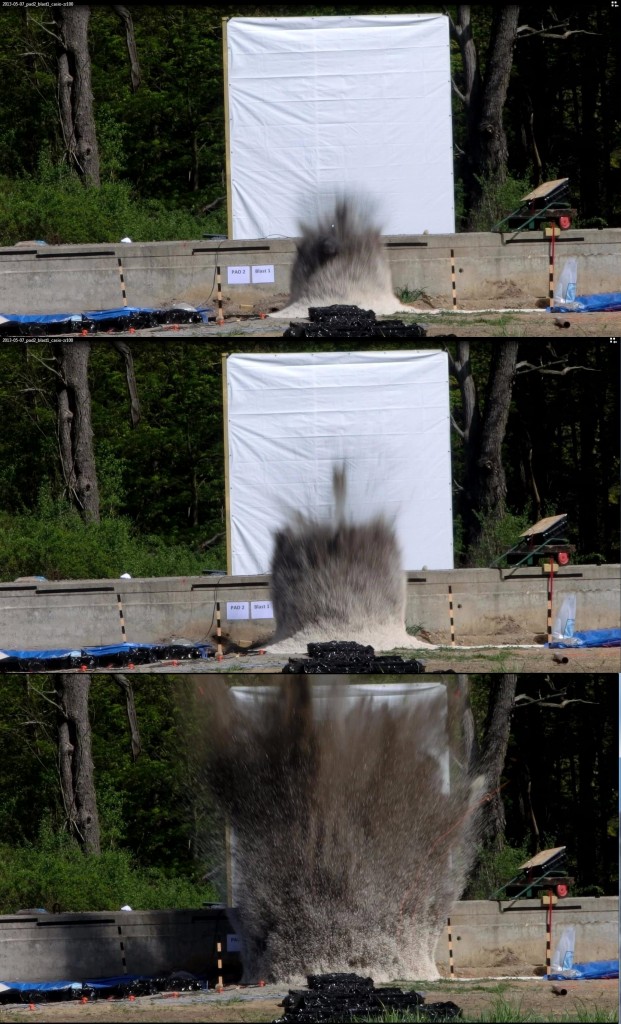
A series of captures from HD video of one of the explosions (courtesy of Alison Graettinger).
Why are we doing this?
Well besides the fact that dynamite is cool… we are investigating the impact of subsurface explosions on surface and subsurface geology. In particular, we are trying to mimic maar volcanoes that are produced through the explosive interaction of magma and groundwater. We can monitor explosions and changes to the surface and subsurface through remote sensing, geophysical techniques and good old excavation and observation. Our deep blast experiments (below the ideal depth for maximum crater formation) produced mixing structures that resemble maar diatremes (the material mixing zone below maar craters).
What was new this year?
The level of instrumentation skyrocketed.
There were 4 high speed cameras, 1 thermal camera, 3 HD cameras, over 30 geophones, more than 7 seismometers, 6 infrasound microphones, 3 traditional microphones, 80 sampling stations, one weather balloon (for infrasound), one robot for photogrammetry, 4 electric field sensors, one pitot tube, 127 ballistic tracers, and lots of observational data. Of these at least 8 instruments were experimental.
[youtube=https://www.youtube.com/watch?v=Pws7od5CgEY]
Here is a blast in action: You can see geophones, sample boxes, a pitot tube, lots of visual scales, a background to help with particle tracking in this image alone. This was captured from one of our high definition videos. If you look closely in the top image you can see a bright light just at the top of the wall. We used this light to synchronize all the videos with the trigger of the explosives. The orange lines to the right side of the blast jet are the charge wires.
The setup had more planning and detail.
Last year we had roughly three 30 cm layers. This year we had five 15 cm layers (depending on depth of charge placement). Our sampling and post-explosion observation techniques were more robust and more consistent. We also had more blasts with a greater range in explosion energy and burial depth.
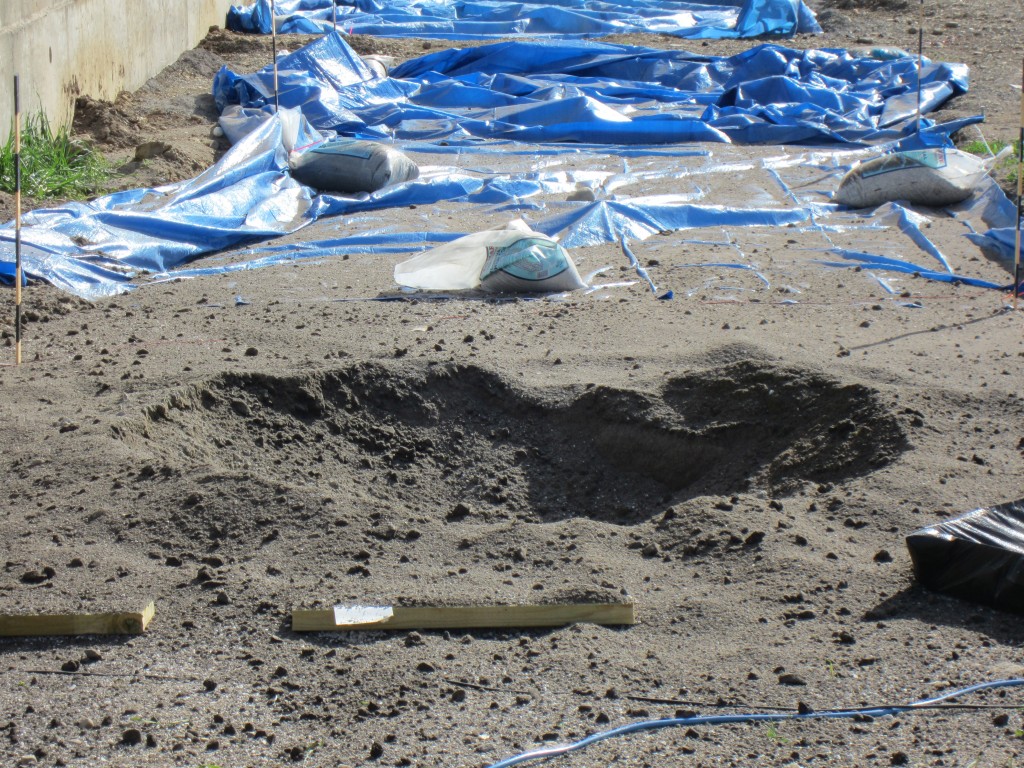
One of the explosion craters immediately after a blast (photo courtesy of Alison Graettinger).
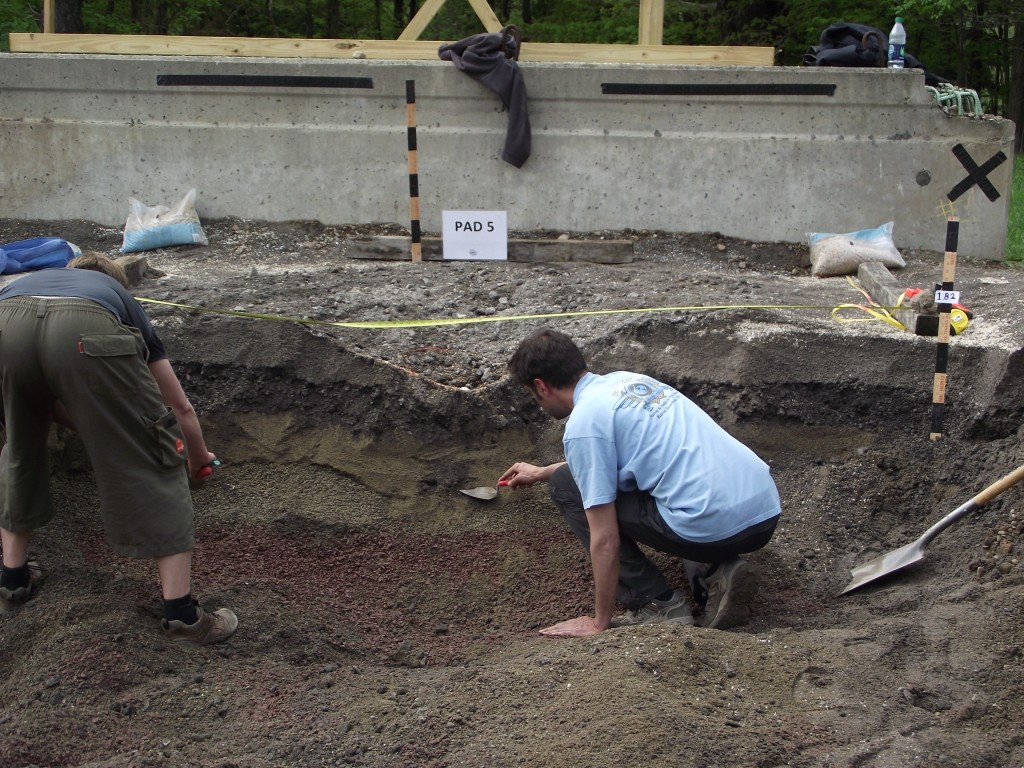
Dissecting an explosion crater to observe and measure subsurface disturbance (photo courtesy of Alison Graettinger)
The number of international collaborators increased.
We had scientists from 5 countries (Canada, Germany, New Zealand, Italy and the US). Representing eleven institutions (mostly universities and INGV). We had nine students, two post-docs and 15 contributing scientists.
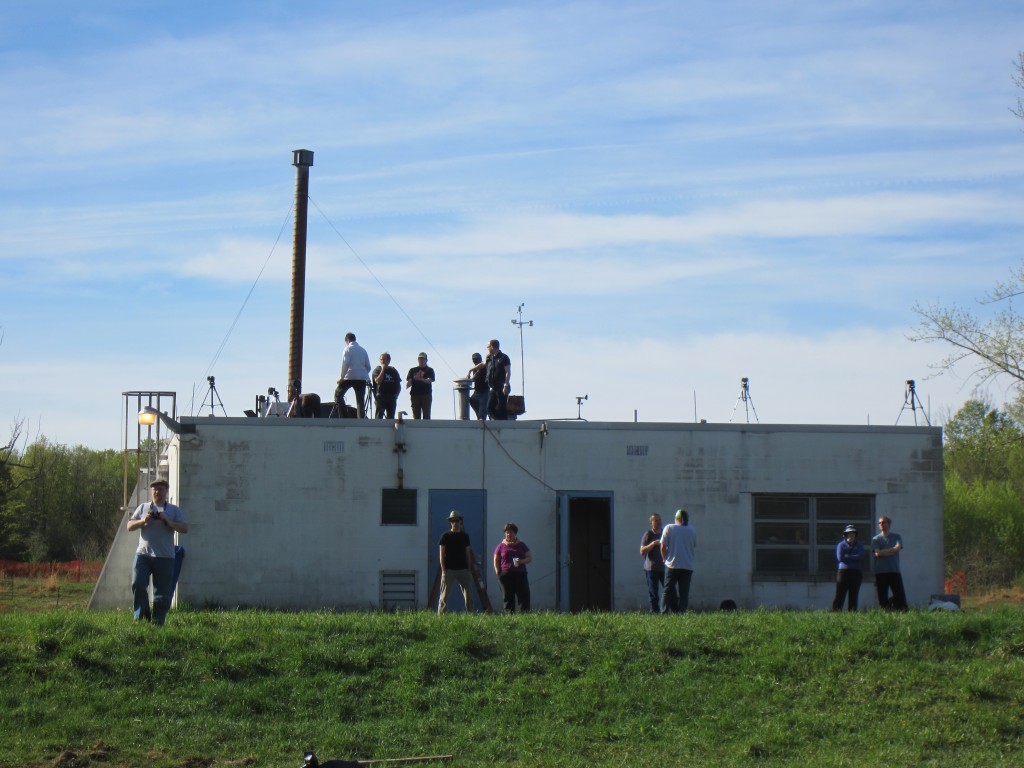
Collaborators getting equipment ready on the roof of the experimental facility building (photo by Jessica Ball).
So what did we make?
Besides making Jessica smile (see photo) because I let her push the ‘button’ when our blaster yelled “fire in the hole,” we produced five complex craters, some produced by up to three individual blasts. We also produced a TON of data. Although we used over 95 tons of material to do the tests, I won’t have to sieve all of it, just what we collected as ‘ballistics’, but we have over 0.5 Terabytes of video and still photography and way too many spreadsheets of morphological and data.
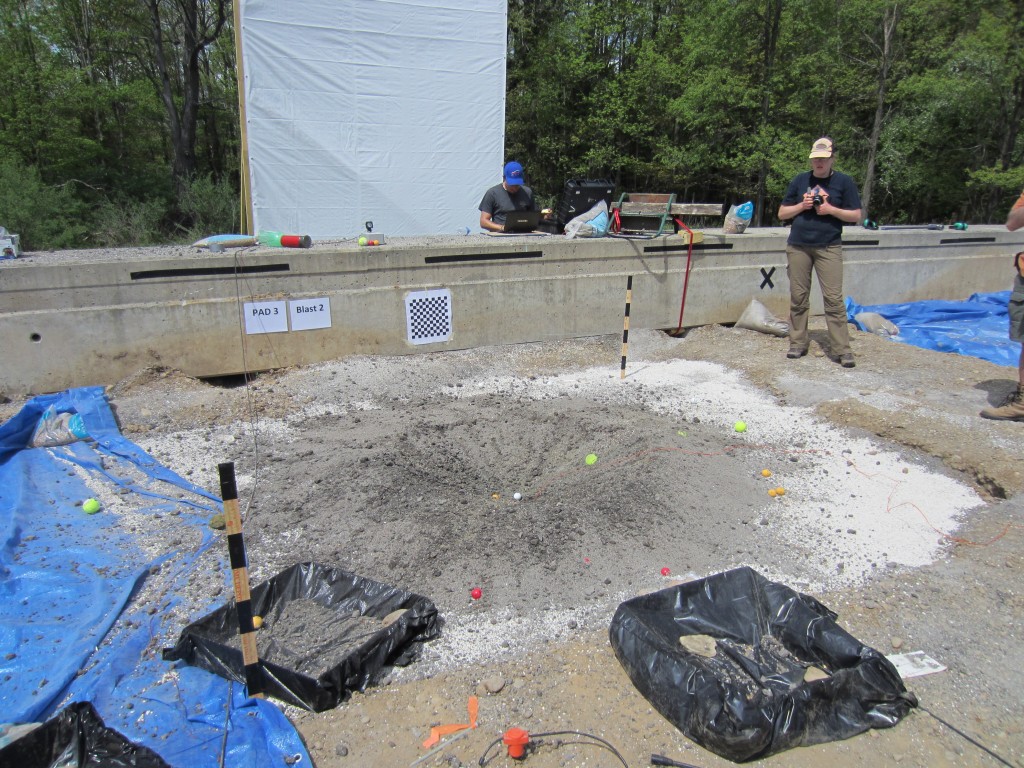
Alison surveying the results of a blast. Boxes in the foreground were used to collect ‘ballistics’ (photo by Jessica Ball).
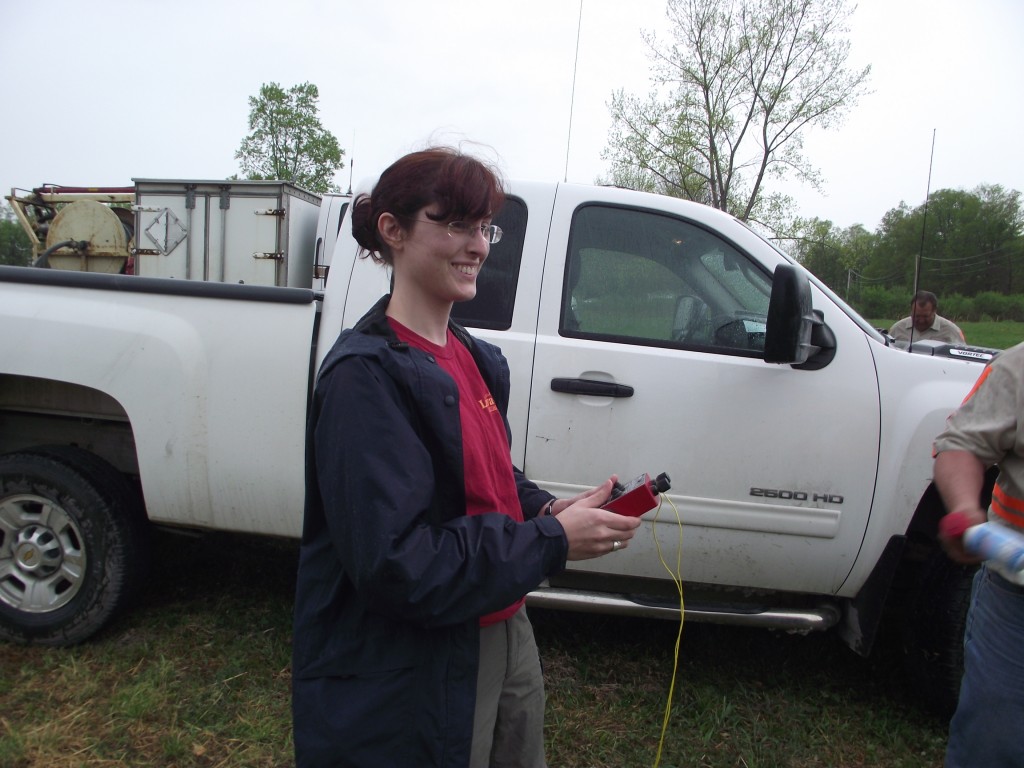
The blog author in control of high explosives (photo courtesy of Alison Graettinger).
What will make this an even more impressive dataset will be the integration of remote sensing, geophysical and geological observations of the blasts and their products in a controlled setting. Normally nature does not let us have this much prep time or gather this much ‘pre-event’ information, but by working under these controlled conditions, we can help calibrate all these instruments for more rugged and less predictable environments (i.e. an erupting volcano).
Keep an eye out for lots of interesting articles like these from last year’s experiments: Valentine et al. 2012, Ross et al. in press, Taddeucci et al. 2013 (see the references below). We anticipate a lot more from the Geohazards Field Station, run by our group as well as other interested research groups with their own ideas and funding. In the meantime, here’s one last video (a high-speed one that was featured by Nature News): http://www.nature.com/news/experimental-volcanoes-make-a-blast-1.12970.
References
Ross, P.-S., White, J.D.L., Valentine, G.A., Taddeucci, J., Sonder, I. and Andrews, R., in press. Experimental birth of a maar-diatreme volcano. Journal of Volcanology and Geothermal Research.
Taddeucci, J., Valentine, G.A., Sonder, I., White, J.D.L., Ross, P.-S. and Scarlato, P., 2013. The effect of pre-existing crater on the initial development of explosive volcanic eruptions: An experimental investigation. Geophysical Research Letters, 40: 507-510.
Valentine, G.A. and White, J.D.L., 2012. Revised conceptual model for maar-diatremes: Subsurface processes, energetics, and eruptive products. Geology, 40(12): 1111-1114.
Valentine, G.A., White, J.D.L., Ross, P.-S., Amin, J., Taddeucci, J., Sonder, I. and Johnson, P.J., 2012. Experimental craters formed by single and multiple buried explosions and implications for volcanic craters with emphasis on maars. Geophysical Research Letters, 39: L20301.











/https://tf-cmsv2-smithsonianmag-media.s3.amazonaws.com/filer_public/34/31/3431771d-41e2-4f97-aed2-c5f1df5295da/gettyimages-1441066266_web.jpg)






Discussion about this post